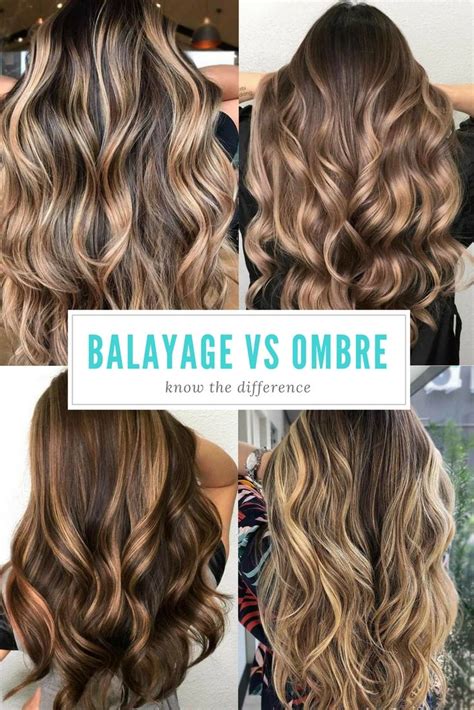In the captivating world of hair coloring, ombre and balayage stand out as two coveted techniques that promise to transform tresses with their effortless yet striking effects. While they share a common goal of creating gradual color transitions, these methods employ distinct strategies and yield unique results, catering to different tastes and hair goals. To navigate the nuances of ombre vs balayage, let’s delve into their intricate details:

1. Color Placement: A Vertical vs Horizontal Divide
Ombre technique: Characterized by a distinctly vertical color gradation. Starts with a darker shade at the roots, seamlessly transitioning to a lighter hue towards the ends. This creates a bold, eye-catching contrast.
Balayage technique: Embraces a more subtle, horizontal approach. Sections of hair are hand-painted, creating soft, sweeping streaks of color that blend seamlessly with the natural base hair.
2. Transition Time: A Gradual Shift vs a Graduated Melt
Ombre technique: Typically involves a more pronounced color change, creating a visible line of demarcation between the dark roots and the lighter ends. The transition can range from gradual to dramatic, depending on the desired effect.
Balayage technique: Blends colors more subtly, resulting in a graduated melt. The highlights and lowlights gently merge, creating a more natural, sun-kissed look. The transition is delicate and seamless.
3. Application Process: Brushstrokes vs Teasing
Ombre technique: Achieved by painting color directly onto the hair using a brush or comb. The roots are left untouched, while the mid-lengths and ends are coated with the lighter shade.
Balayage technique: Involves a more intricate and freehand approach. Hair is sectioned and teased at the roots to create lift and allow the colorist to gently distribute the lightener. This results in softer, diffused streaks.
4. Maintenance: Roots vs Blending
Ombre technique: Requires regular touch-ups as the roots grow out, especially if you desire to maintain the contrast between the dark and light sections.
Balayage technique: Offers lower-maintenance upkeep since the blended highlights seamlessly merge with the natural hair color as it grows.
5. Cost Factor: A Price Difference to Consider
Ombre technique: Generally more affordable due to its simpler application process.
Balayage technique: Usually costlier due to the time-intensive and skilled hand-painting involved.
Tailoring to Your Style: Which Technique Suits Your Vision?
Opt for ombre if you seek:
- A dramatic color transformation with a bold, contrasting effect
- A low-maintenance hairstyle that requires less frequent touch-ups
- A classic, eye-catching look that remains timeless
Consider balayage if you prefer:
- A subtle, natural-looking hair color with blended transitions
- A style that requires less maintenance and grows out gracefully
- A technique that allows for greater customization and personalized effects
To help you make an informed decision, consult with a professional hairstylist who can assess your hair texture, color, and desired outcome to recommend the most suitable technique.
Beyond the Basics: Innovative Applications of Ombre and Balayage
Ombre in Reverse: This trend reverses the traditional ombre, creating lighter roots and darker ends. It’s ideal for those seeking a subtle yet impactful change.
Subtle Balayage: A variation of balayage that uses minimal color and low contrast, resulting in a whisper-soft enhancement of natural hair tones.
Dimensional Balayage: This technique involves using multiple shades of highlights and lowlights to create depth and dimension, mimicking the natural play of light and shadow in hair.
Fashion Forward Balayage: Embracing vibrant colors and bold hues, this approach transforms hair into a canvas of artistic expression. From pastel streaks to metallic accents, the possibilities are endless.
Market Trends and Consumer Insights
According to a recent survey conducted by the National Cosmetology Association, ombre and balayage accounted for over 60% of professional hair coloring services in 2023. The popularity of these techniques is driven by their versatility, allowing them to complement a wide range of hair types and styles.
Consumers are increasingly seeking low-maintenance hair color solutions that enhance their natural beauty without requiring excessive upkeep. Both ombre and balayage fulfill this need, providing stunning results with varying levels of maintenance depending on the technique and desired effect.
Step-by-Step Guide to Achieving Ombre or Balayage at Home
Ombre Technique:
- Divide hair into two sections, tying up the upper half.
- Apply bleach or color to the bottom half, avoiding the roots.
- Process according to the manufacturer’s instructions.
- Rinse thoroughly and towel dry.
- Section the hair again and apply a toner to blend the transition.
- Rinse and style as desired.
Balayage Technique:
- Section hair into small strands.
- Backcomb the roots slightly to create lift.
- Apply bleach or color to the ends of the strands using a brush or sponge.
- Process according to the manufacturer’s instructions.
- Rinse thoroughly and towel dry.
- Tone if necessary to blend the highlights.
- Rinse and style as desired.
Frequently Asked Questions
Q: Which technique is better for dark hair?
A: Balayage is more suitable for dark hair as it creates subtle, blended highlights that enhance the natural depth of the hair.
Q: Can I do ombre or balayage on my own?
A: Yes, but it’s recommended to consult a professional hairstylist for guidance, especially if you have complex hair color or desire a dramatic transformation.
Q: How long does it take to get an ombre or balayage done?
A: The duration varies depending on the length and thickness of your hair, as well as the desired effect. Ombre typically takes less time, while balayage can be a more time-intensive process.
Q: Which technique is more damaging to hair?
A: Both techniques involve chemical processes that can damage hair to some extent. However, balayage is generally considered to be less damaging as it targets smaller sections of hair and uses a more gentle application process.
Q: Which technique is better for short hair?
A: Balayage is a more suitable choice for short hair as it provides greater control and precision, allowing for seamless blending and customized effects.
